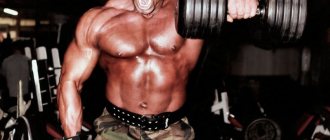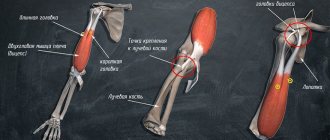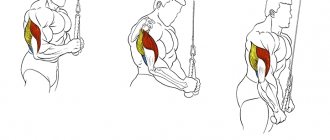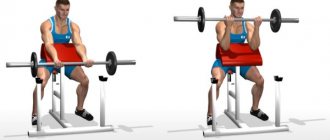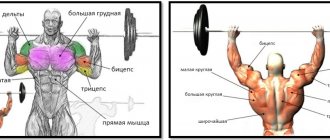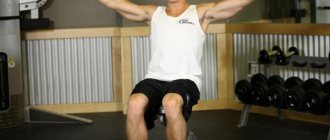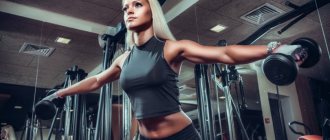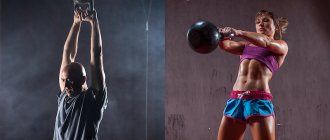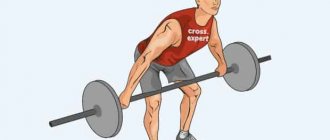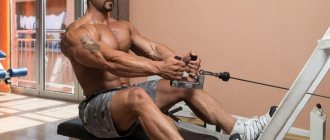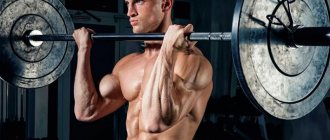Author: Timko Ilya - the ruler of the entire site and fitness trainer | more details >> Rod. 1984 Trained since 1999 Trained since 2007. Author and creator of the site tvoytrener.com. CCM in powerlifting. Champion of Russia and South Russia according to AWPC. Champion of the Krasnodar region according to IPF. 1st category in weightlifting. 2-time winner of the Krasnodar Territory championship in t/a. Author of more than 700 articles on fitness and amateur athletics. Author and co-author of 5 books.
Place in the author rating:
out of competition
(become an author) Date: 2012-05-29 Views: 142,398 Rating: 4.0
| All articles by the author >> | Medals articles >> |
Articles are loading...
| Article medals: | more than 100 thousand views |
Why medals are given to articles:
| Bronze medal: | |
| 1. The article is in the TOP 100 2. The article has more than 3. The article has more than 100 | |
| Silver medal: | |
| 1. The article is in the TOP 50 2. The article has more than 3. The article has more than 500 | |
| Gold medal: | |
| 1. The article is in the TOP 10 2. The article has more than 1 3. The article has more than 1,000 | |
Main muscles - anterior delta Additional - no (with the correct technique) Difficulty of execution - easy
Anatomical atlas
Of course, it loads many muscle groups, therefore, it refers to multi-joint training:
- the load is directed mainly to the anterior bundles of the deltoid muscle;
- synergists here: serrated anterior muscles, triceps, lower and middle trapezius, supraspinatus, lateral deltas;
- the dynamic stabilizer is the long head of the triceps;
- the muscles responsible for raising the shoulder blades and the top of the trapezius act as stabilizers.
At the same time, the biceps, large and pectoral muscles work, and the abs are loaded.
Common mistakes and recommendations when performing dumbbell lifts
Most novice athletes make the following common mistakes when performing an exercise:
- The torso is strongly tilted back, resulting in the rise occurring while rocking. This risks the fact that the main load from the shoulders will go to the pectoral muscles.
- When the arms and dumbbells are lowered, they hit the hips, which leads to a decrease in tension in the anterior deltoid muscle. The muscle must be in good shape all the time, otherwise muscle growth will be slow.
To achieve maximum efficiency, we recommend that you adhere to the following rules:
- When lifting and lowering, keep your arms slightly bent at the elbows.
- When you start lifting dumbbells, you don’t need to jerk or try to throw the dumbbells.
- Lowering the dumbbells should be smooth and controlled. There is no need to completely relax your arms and make sudden lowerings.
- Do not lift the dumbbells above chin level. In this case, the load will transfer to the trapezius muscles.
- You need to lift dumbbells without the help of your leg and core muscles.
- Make sure that your arms are always symmetrical when lifting and lowering.
Strong and toned shoulders make any man athletic, handsome and attractive. The deltoid muscle bundles are not as large compared to the biceps, so you will not have to spend much time on their development. By regularly doing dumbbell lifts in front of you, you will get wide and sculpted shoulders.
What is unique about the standing barbell press?
This exercise is basic for pumping the deltoid muscles. Due to the fact that the work is carried out with free weight, the stabilizer muscles are also tensed during the exercise.
By regularly performing standing barbell presses, you can increase the strength of the shoulder girdle muscles.
During the exercise, the shoulders, pectoral muscles, triceps and back are included. The abdominal muscles, legs, and torso extensors act as stabilizers.
Benefits of the Military Press
To begin with, this movement did not come from the training of US Navy SEALs, as is commonly written everywhere in RuNet, but as a traditional element of training weightlifters. The SEALs really do it, since a good military press will help both throw a bag onto a support and pull out a wounded comrade if something happens.
The military press allows you to develop not so much the strength of the shoulders and triceps themselves, but rather the synergy in the movement of the legs, body, and arms. In addition, it allows you to increase the strength of the entire upper body precisely due to stabilization. It also serves as an excellent special-preparatory movement for a good half of bench press exercises, and partly for strength-speed exercises, such as clean and jerks.
All this has led to the high popularity of the exercise in modern times. In fact, it was not powerlifting or bodybuilding that “infected” the masses with this movement, but CrossFit. When many people came to CrossFit boxes in order to become as cool as those guys in the video, they discovered that they lacked not only strength indicators, but also endurance, as well as banal amplitude in the joints.
The military press was also respected by old school bodybuilders. Most of them trained in one way or another with coaches who came from Soviet weightlifting. In this form, lifting weights overhead is a basic movement.
The benefits of the exercise do not end with its applied significance for various disciplines. Being basic, it involves most of the muscles of the upper body. This allows the athlete to effectively build muscle mass and activate neuromuscular connections, as a result, the gain will actually happen faster than if you do only isolation in the gym.
In addition to the shoulders, the movement works great on the triceps. It allows you to change the shape of your hands. Therefore, the military bench press is often given to girls who want to quickly tone their arms, no matter how paradoxical it may sound.
With the correct technique, movement serves as an excellent prevention of problems arising due to insufficiently active blood circulation in the cervical-collar area. A number of sources mention that the military bench press is a prevention of trapezius hypertonicity in security forces and headaches associated with muscle spasms.
The exercise has a lot of them:
- simultaneous load on a large number of muscles;
- productive work out of the upper body;
- increase in strength indicators:
- the power effort necessary for strength training develops;
- muscle mass gain;
- improvement of shoulder “well-being” thanks to delta training.
Correct technique
This exercise, which is difficult in terms of coordination, requires strict adherence to the technique, which is presented step by step below.
Preparatory step: you need a bench, sitting on it across or along (located between your legs), you need to grab the barbell with a grip wider than your shoulders. Place it on your upper chest. Keep your back straight. This is the starting position from which the training is performed.
First step: inhale, then exhale, simultaneously squeezing the projectile upward. It should be directly above your head. Inhale again and return to the starting position to repeat the exercise.
To make it clearer, a picture is given below.
Standing overhead barbell press
When performing an exercise such as the overhead press, the main target is the shoulder muscles. In addition, the triceps and some other muscles located nearby will be actively involved.
The overhead press is a strength-building exercise. The difficulty level of the barbell overhead press is considered average.
With this option, the elbows are truly in an unnatural position, so there is a risk of injury. But, if you take adequate weights, and before the bench press while sitting, you carry out training that strengthens the rotator cuff, then the “dangerous” exercise will bring nothing but benefits.
Shoulder anatomy
The shoulder muscle is otherwise called the “delta” for its similarity to the triangular shape of the Latin letter of the same name. The biceps and triceps are located lower and do not belong to the deltoid muscle. Therefore, an athlete doing shoulder exercises must understand that as a result, only his upper arms will be pumped up, but not his arms themselves. It is for this reason that delt exercises are suitable for girls who want to have relatively broad shoulders, but do not want to be too muscular.
The deltoid muscle is attached to three bones: the humerus, scapula and clavicle. When performing exercises, take into account the individual characteristics of the body. If you have had fractures or dislocations of the listed bones, it is recommended to exercise only with a trainer, and loads should be limited. A similar requirement applies to injuries of the shoulder joints or their ligaments.
The delta consists of three bundles: anterior, middle (lateral) and posterior. Let's look at their location and participation in training in more detail in the table.
Useful tips
The following tips will help you get the most out of the exercise and avoid injury:
- the grip is chosen such that the angle between the shoulder and forearm is straight at the lowest point of the trajectory;
- you need to direct your gaze forward, for which you choose a point in front of you (on the wall), which you look at during the entire exercise;
- in order to control the trajectory of the barbell, at first it is advisable to perform the exercise in front of a mirror (lateral projection);
- to support the lower back, when moving to medium and heavy weights, it is necessary to use a weightlifting belt;
- For the same purpose, you can use the bar located on the stand of the bench press. The middle of the back is leaned against it;
- the arms are not fully extended at the top point: the elbow joint is slightly bent;
- for those who have problems with the rotator cuff muscle, it is not recommended to perform a barbell bench press while sitting with the apparatus behind the head (do it from the chest);
- keep your back straight throughout the training;
- lifting and lowering the weight is carried out without jerking - smoothly and controlled;
- use the entire range of motion available to the barbell;
- below and above do not rest.
Standing chest press
The standing chest press is a key exercise for developing the muscles of the shoulder girdle and arm muscles. Since the correct technique involves lifting the weight above your head with stationary legs and tense abs, this exercise indirectly develops the core muscles. This is why the standing barbell press is one of the five basic exercises for muscle growth.
In addition, the standing press is considered one of the best ways to strengthen the muscles involved in performing pull-ups on the bar - primarily the latissimus dorsi, posterior deltoids, and trapezius. Regularly performing standing barbell presses from the chest helps create a broad-shouldered figure with a confident, athletic posture and strong arms.
It is important to note that the main disadvantage of the standing barbell press is its technical complexity and the increased risk of injury to the shoulder joint if the technique is incorrect - including variations with dumbbells. It must be remembered that beginner athletes are recommended to perform this exercise exclusively with moderate working weight and under the supervision of a trainer.
This exercise is simply irreplaceable for those who want to develop the muscles of the shoulder girdle, and in addition, increase the overall volume of muscles.
The military press is an extremely productive exercise, which is included in the list of mandatory exercises in the American army.
The weight must be set so that eight to twelve repetitions can be performed. We take the barbell at chest level, point our palms away from ourselves, and place our arms wider than shoulder-width apart.
When lifting the barbell, your shoulders should be pulled back a little, and your chest, on the contrary, should be pushed forward a little, thus maintaining the correct curve of the spine. When lifting the barbell, your arms must be fully straightened. It is not advisable to lower the barbell below the clavicular cavity.
It is important to keep your torso straight, otherwise you will not be able to create normal support for performing the exercise.
You should not carry too much weight, as it can pull you back, which will inevitably lead to loss of balance and even injury. It is important to watch exactly how you hold the barbell. Remember, your thumb must grip the bar securely, otherwise you may drop the barbell.
You need to press the barbell above your head, and in no case, in front of you. From time to time you need to pay attention to the flexibility of the shoulder joints and warm them up properly.
The standing barbell chest press is not suitable for people who have problems with the spine or shoulder girdle. In general, before you start performing this exercise, it would be a good idea to consult a doctor.
Basic shoulder exercises
Overhead Barbell Press and Chest Up Press
video - chest press
The barbell overhead press is one of the best exercises for building mass in the deltoid muscles of the shoulders.
Overhead barbell press
The main work is performed by the lateral and anterior delta bundles.
- sit on a bench, place the barbell on your shoulders;
- chest forward, shoulder blades together;
- grip slightly wider than shoulders - at the bottom point of the forearms perpendicular to the floor;
- press the barbell above your head until your arms are straightened, while your head tilts slightly forward;
- slowly lower the barbell to the base of your neck and repeat the exercise.
If you want to reduce the load on your spine, perform the exercise while sitting on a bench with a backrest.
Barbell Chest Press
The barbell chest press shifts the load to the front deltoids.
- When lowering the barbell to your chest, bring your elbows forward slightly;
- press the barbell up in the same way as when doing an overhead press - do not lean back or forward, your arms with the barbell are in the same plane as your body - perpendicular to the floor.
EZ-bar chin row
video - EZ-bar row to the chin
Chin rows are best performed with an EZ curved bar or dumbbells. This takes extra stress off your wrists, and they will be in a more natural position during the exercise.
- take the barbell with a grip slightly narrower than your shoulders;
- bend your elbows slightly;
- pull the barbell up using your shoulder muscles, trying to involve your biceps and triceps as little as possible;
- The shoulders are always higher than the forearms, the goal of the exercise is to raise the shoulders to parallel with the floor or slightly higher, and not to touch the chin with the barbell.
Standing overhead barbell press
Among athletes, this issue is quite pressing. Some prefer the standing press, others prefer the seated press.
The famous Dr. Ken, who has been dealing with the issue of gaining muscle mass for many years, gave the palm to the standing press.
Why? This exercise is much more difficult to perform, so more muscles are involved in the work. However, there are people who, due to health reasons, are not able to do the barbell press while standing, and for them it is better to do the seated version. The standing press is somewhat related to one of the most difficult exercises in bodybuilding - squats with a barbell. If you are confident that you can do a standing press, do it. If not, it is better to find a replacement. For example, seated press.
The standing press requires much greater control on the part of the athlete over his own body and the barbell. When trying to keep the body in a strictly vertical position, the lower back and even the hips are included in the work. The forces affecting the spinal column are dissipated through the legs, which reduces the load on the spine.
In some cases, with incorrect technique or incorrectly chosen weight, the spinal column is still subject to compression. Many Olympic weightlifters have suffered precisely because of compression loads on the spine.
Unfortunately, many athletes have poor coordination, and therefore cannot subject their triceps and deltoids to adequate load. Essentially, they are unable to properly control their body and the bar when performing the bench press. Such athletes need to especially carefully monitor the weight of the projectile.
The seated press is generally a safer exercise, but only if you provide additional support to your back. This option has a serious disadvantage - the compression load is not dissipated through the legs. When the muscles of the belt are stressed, the connective tissues are in a static position. Therefore, the effectiveness of the seated press for gaining muscle mass should be considered less significant than that of the standing press.
Performing any type of standing barbell press allows you to broaden your shoulders and give them a rounded, voluminous shape. The exercises described above are performed not only by weightlifters, but also by gymnasts, shot throwers, even volleyball and tennis players. The fact is that shoulder development leads to obvious progress in any sport.
The standing barbell press for fitness and bodybuilding is a cult exercise that is performed by both men and women. It has a powerful effect on the body, which accelerates metabolism, which allows muscle mass to grow much faster.
Personal trainer, pharmacologist, nutritionist
Draws up and conducts personal training programs for body correction. Specializes in sports traumatology and physiotherapy. Conducts classical medical and sports massage sessions.
Other authors
The lower back is not “friendly” with “sedentary” loads, so people who move little (office workers, etc.) suffer from lower back pain. To unload the back, a barbell press is best suited for them, but from a “standing” position, not a “sitting” one, during which there is less shearing lateral force.
Safety is no less important: it is easier for an athlete who makes movements while standing to drop the barbell to the floor. When performing a seated barbell press, this cannot be done without the help of a partner. Therefore, it is recommended to do a standing military chest press. The barbell overhead press is done while sitting on a Scott bench.
Description of the exercise
Bend your elbows slightly. You can also take it with an underhand grip, then more load will fall on the inner part of the front deltoid. It is better to raise the barbell to shoulder level, or slightly higher. Use this exercise only as an additional exercise, after you have done the basic shoulder exercises.
Main features
1. This exercise can also be done with a disc. The advantage is that when you turn your hands with your palms facing each other, the load shifts to the inner part of the front deltoid (the part closer to the chest).
2. And if you grab the barbell with your palms up, the load will shift even more inside the front deltoid.
3. Your arms should be slightly bent at the elbows. This will protect them (elbows) from injury.
4. Another option is to do this exercise from the lower block in a crossover. The difference is that with a barbell the load on the muscles is minimal at the bottom and maximum at the top. But in a crossover it is the same throughout the entire amplitude.
5. It is better to raise your arms to a level just above your shoulders. And lower it all the way down.
6. Try not to sway your body. You understand that the projectile must be lifted by muscle strength, and not by the inertia of the body.
7. Take the weight so that you can do at least 8 repetitions correctly.
8. The grip width should be slightly narrower than your shoulders. The narrower the grip, the more the front deltoids contract.
Standing Dumbbell Press
If you are unable to work with a personal trainer to improve your standing chest press technique, you can replace this exercise with a dumbbell press. Beginners are recommended to start by doing the exercise while sitting (this allows you to focus on feeling the work of the muscles of the shoulder girdle), gradually moving on to the standing dumbbell press, and then to the barbell.
However, avoid using overly heavy dumbbells - when training shoulder muscles with dumbbells, it is not just the maximum working weight that is important, but only the correct technique for performing the exercise. Since the shoulder joint is considered one of the most easily injured joints, even the slightest mistakes in its training can cause serious sports injuries.
Exercises with a barbell are attractive because progress in the development of muscles and strength occurs more quickly. This is explained by the fact that training allows you to lift very large weights. But it must also be said about the disadvantages: the stronger hand, taking on the main load, does not allow the development of the other, which lags behind it in development, which leads to the appearance of asymmetry, unbalanced muscle development. For development, the barbell press is very productive if done while sitting.
You can choose a different tactic: train for a couple of months, doing military presses, and then move on to training with dumbbells.
How to properly lift dumbbells?
There are three main varieties of this exercise, which have approximately the same technique:
- classic version: you lift dumbbells in front of you with both hands at the same time;
- alternating option: you lift dumbbells with each hand in turn;
- Single dumbbell front raise: You hold one dumbbell with both hands and lift it in front of you.
First you need to choose the right dumbbell weight. If you are a beginner, you should not immediately lift heavy weights. First you need to strengthen the muscles of the shoulder girdle using light weights. Girls can use dumbbells weighing 2–3 kg. Men can start with 5-6 kg dumbbells. After a few sessions, when your deltoid muscles become stronger, you can choose the optimal weight, depending on your level of training and body weight. The anterior deltoid muscle gets tired very quickly, so don’t start with heavy weights right away.
Men can gradually increase the weight of dumbbells to 20 kg. The weight must be increased gradually (no more than 2 kg per workout). It is also important to understand the purpose of shoulder training. If you are working on increasing strength, then you need to take maximum weights for a minimum number of repetitions. If you are working to improve muscle definition, then you need to take weights with which you can perform a fairly large number of repetitions. Lifting two heavy dumbbells at the same time will be extremely uncomfortable, so when you are working with heavy weights, it is better to perform dumbbell lifts with each hand in turn.
Classic two-hand dumbbell lift
To perform this exercise, two types of dumbbell grips are used. The first one is palms down. The second is a neutral grip, with your palms facing each other. In most cases, a palms down grip is used.
- The starting position is standing. Feet shoulder-width apart, shoulders straightened and lowered down.
- Take dumbbells and place them in front of you at approximately hip level.
- Straighten your back, hands with dumbbells should not touch your hips. The arms should be slightly bent at the elbow joint;
- Raise your arm until it is parallel to the floor (this is approximately the level of your chin). The movement of raising the arms is performed while inhaling. The movement is performed only with the help of the shoulder muscles.
- The distance between your hands when lifting should be equal to the width of your shoulders. Make sure that your arms do not go to the sides when lifting.
- When the level of the chin is reached, you need to stay in this position for 1-2 seconds in order to maximally engage the muscles in the work.
- Smoothly lower your arms as you exhale and return to the starting position.
The video shows in more detail the technique of lifting dumbbells without using an inclined bench.
Video: Varieties and techniques for lifting dumbbells
Alternating lift option
The technique of performing alternating lifts is similar to the classic version. The only difference is that the arms with dumbbells are raised one by one. First, while inhaling, raise one hand and hold it for 1–2 seconds. As you exhale, lower your hand and repeat the exercise only with the second hand. The alternating option of lifting dumbbells in front of you is recommended when working with heavy weights.
Frontal raise of one dumbbell in front of you - working your shoulders
The frontal lift allows you to create a more isolated load on the front deltoids. For convenience, you can lift not a dumbbell, but a plate from a barbell of the appropriate weight.
- We take the starting position. We place our feet approximately shoulder-width apart, with our shoulders straightened and lowered down.
- We take one dumbbell with both hands, with the palms facing each other. Elbows can be bent.
- As you inhale, raise your hands to chin level and hold in this position for 1–2 seconds.
- As you exhale, lower your arms and return to the starting position.
